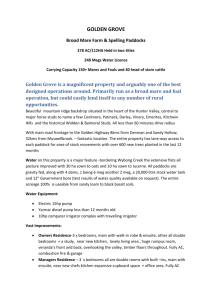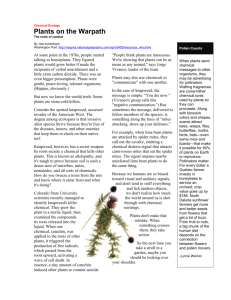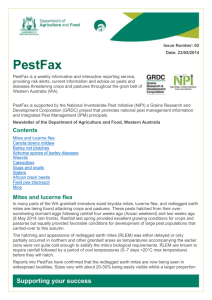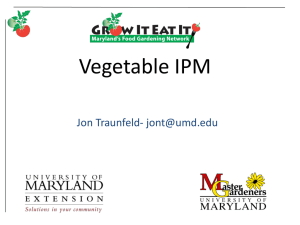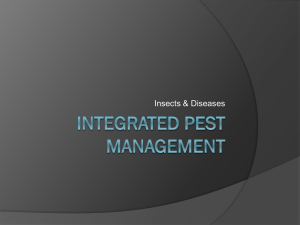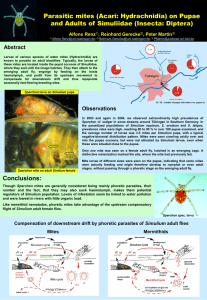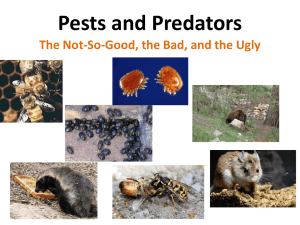PestFax editor - Department of Agriculture and Food
advertisement
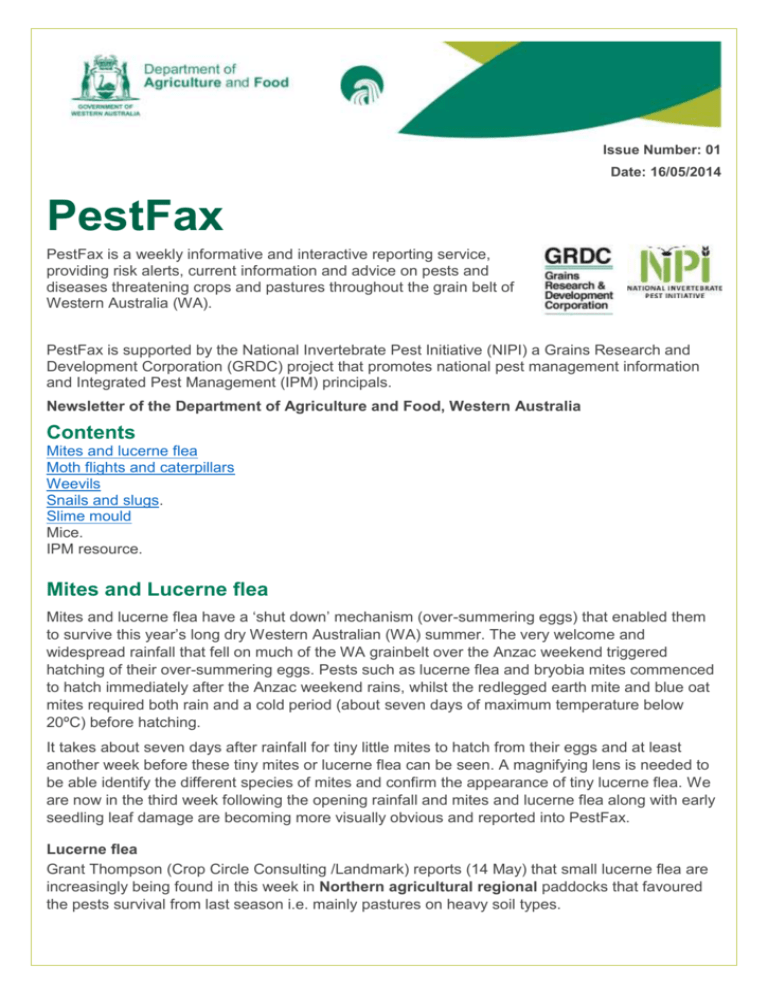
Issue Number: 01 Date: 16/05/2014 PestFax PestFax is a weekly informative and interactive reporting service, providing risk alerts, current information and advice on pests and diseases threatening crops and pastures throughout the grain belt of Western Australia (WA). PestFax is supported by the National Invertebrate Pest Initiative (NIPI) a Grains Research and Development Corporation (GRDC) project that promotes national pest management information and Integrated Pest Management (IPM) principals. Newsletter of the Department of Agriculture and Food, Western Australia Contents Mites and lucerne flea Moth flights and caterpillars Weevils Snails and slugs. Slime mould Mice. IPM resource. Mites and Lucerne flea Mites and lucerne flea have a ‘shut down’ mechanism (over-summering eggs) that enabled them to survive this year’s long dry Western Australian (WA) summer. The very welcome and widespread rainfall that fell on much of the WA grainbelt over the Anzac weekend triggered hatching of their over-summering eggs. Pests such as lucerne flea and bryobia mites commenced to hatch immediately after the Anzac weekend rains, whilst the redlegged earth mite and blue oat mites required both rain and a cold period (about seven days of maximum temperature below 20ºC) before hatching. It takes about seven days after rainfall for tiny little mites to hatch from their eggs and at least another week before these tiny mites or lucerne flea can be seen. A magnifying lens is needed to be able identify the different species of mites and confirm the appearance of tiny lucerne flea. We are now in the third week following the opening rainfall and mites and lucerne flea along with early seedling leaf damage are becoming more visually obvious and reported into PestFax. Lucerne flea Grant Thompson (Crop Circle Consulting /Landmark) reports (14 May) that small lucerne flea are increasingly being found in this week in Northern agricultural regional paddocks that favoured the pests survival from last season i.e. mainly pastures on heavy soil types. Courtney Piesse (Elders) reports (12 May) that lucerne flea hatched in the Kojonup area. Early damage was mainly seen on some volunteer crops but was a good indicator of their activity and warning to be monitoring newly emerging crops. Ty Henning (TekAg) reports (16 May) that a newly emerged canola crop at Cunderdin has been badly damaged by large numbers of lucerne flea. The lucerne fleas are of varying sizes indicating that at least two hatching events occurred. Surprisingly the large number of lucerne flea ‘carryover’ between seasons originated from breeding on last season’s wheat crop. Ty also has seen damaging levels of lucerne flea on other emerging crops near Dalwallinu and East Pithara. Ashton Gray (ConsultAg) reports (15 May) finding lucerne flea damage to emerging canola crops this week including crops near Quairading and Lake Grace and on a lupin crop near Cuballing. Ashton says that the lucerne flea are increasing in size and can be easily seen feeding on leaves where they are in damaging levels. Some paddocks had 200mL/ha alpha cypermethrin applied post sowing pre-emergence (PSPE) for control of other pests but as expected this had no effect on the lucerne flea. Bryobia mites Chloe Bairstow (Landmark) reported (12 May 14) seeing a lot of bryobia mites in the Lake Grace area. An Agronomist reported to Southern Department of Agriculture and Food, Western Australia (DAFWA) staff late last week (8 May 2014) that small bryobia mite and early damage was being found on very early sown crops in the South Stirlings area. Ty Henning (TekAg) also found bryobia mites along with lucerne flea attacking canola cotyledons near Cunderdin. Redlegged earth mites (RLEM) No hatching of redlegged earth mites has been reported to date from many Northern cropping areas as temperatures have generally been above those required for the mites to hatch. Entomologist Svet Micic reports (14 May 2014) that tiny redlegged earth mites have been found commencing to cause damage to pasture near the Porongurups. Paul Sanford (DAFWA) reports that there are large hatchings of redlegged earth mites on newly seeded pasture in the South Stirlings area. The pasture is just at emergence, and sprays are being applied. Ashton Gray (ConsultAg) reports (15 May 2014) finding small redlegged earth mites in combination with lucerne flea in seedling crops he inspected this week in the Cuballing area. What can we expect? An increase in the size of mites and lucerne flea will become more noticeable over the next few weeks as they approach their adult growth stage. Corresponding damage to plants by their larger mouth parts will also be more obvious in situations where high numbers of these pests are uncontrolled. Mites and lucerne flea of various growth stages may also become noticeable in localities where a staggered hatching of their eggs occurred following separate rainfall events (e.g. 27 April and 8 May). Control and risk situations Many growers who sowed crops before or during the opening rains did not apply any preventative insecticides. They did this safe in the knowledge that crops would germinate and grow rapidly with good rainfall and warm soil conditions and be well ahead of any risk from pests that would be hatching or at an immature growth stage when canola crops were advanced to 2-4 leaf growth stage. Paddocks that are yet to be sown will be in a much higher risk category. Those that were in pasture (especially with large quantities of legume or capeweed) last spring are likely to have a much higher ‘carry over’ risk of pests between seasons than cereal crops, whilst legume and canola crops generally have an intermediate risk of pests. All paddocks should ideally be monitored on a few occasions and in randomised spots throughout the paddock to identify what pests are currently resident and feeding on weed cover. An appropriate insecticide and rate can then be chosen to target those pests. In some cases where pest distribution is patchy, as is often the case with lucerne flea only part of a paddock may need to be sprayed. At this time of the year it is usually ideal to incorporate the insecticide(s) in with the knock-down herbicides that will be applied pre-sowing. Mite control in developing self-sown pastures or re-seeded pastures is preferably applied before mites and RLEM reach their fully grown adult growth stage and commence to lay their ‘winter’ eggs. Time taken to inspect paddocks over coming weeks and know what insects are present is well worthwhile as the appropriate chemicals can be selected to do the job. Insecticide sprays inappropriately applied to the "wrong pest" can be very costly resulting in plant damage or the need to re-seed. Insurance sprays of chemicals "just in case" are often a waste of money and may lead to other problems by killing off beneficial insects and increasing the risk of developing insecticide resistance in pests, such as redlegged earth mites. Insecticide control failure A growing number of WA cropping properties (more than 26) have been identified has having redlegged earth mites that are resistance to high rates of synthetic pyrethroid (SP) chemicals such as bifenthrin and alphacypermethrin since the first discovery of this resistance in WA in 2006. Many of the growers who had laboratory testing of their mites to confirm this resistance are now managing their paddocks to successfully limit and prevent spread of these mites over their paddocks. Growers and agronomists who observe surviving redlegged earth mites following applications of insecticides such as bifenthrin or alphacypermethrin should take advantage of a free testing service this year to determine the resistance status of their mites. The testing service is funded by the Grains Research and Development Corporation in 2014/15 and is conducted by DAFWA researchers in collaboration with CSIRO, University of Western Australia and CESAR. To take advantage of this free service contact: Svet Micic, DAFWA Albany Email: svetlana.micic@agric.wa.gov.au Phone: +61 (0)8 98928591 or +61 (0) 427 772 051 Peter Mangano DAFWA Perth Email: pmangano@agric.wa.gov.au Phone: +61 (0)8 9368 9753 or +61 (0) 404 819 534 For further information see the following links: – Diagnosing redlegged earth mites and Prevent redlegged earth mite resistance Moth flights and caterpillars Reports have been received by DAFWA staff of moth flights over widespread agricultural areas. The flights have been seen for several weeks and are likely to continue for the remainder of this month. All sorts of moths are being seen congregating around farm lights at night or seen in tractor headlights, especially on warmer nights. The moth flights are an expected occurrence at this time of the year. There are an assortment of moth species some which will have migrated long distances carried along by prevailing winds whilst others originated locally. Some of the larger moths — 25 millimetres (mm) length or more — with darker patterns and markings on the wings will be cutworm and brown pasture loopers. Other smaller (10-12 mm) and straw coloured slender moths with a protruding “beak” like snout will be pasture webworm moths and the weed web moth. Pictures of these moths are available in Crop Insects: the Ute Guide booklet (P.22 to 33). There is also a wide array of other native moths that are non-agricultural pests that will be in abundance and can look very similar in appearance to pest moths. Many of our WA pest moth species with a one year lifecycle are committed to lay their eggs during April and May. If their eggs, are laid into green weedy paddocks the newly hatched caterpillars will have a supply of feed on which to grow. Small caterpillars will now be found in some paddocks that resulted from moth eggs laid in recent weeks. Ty Henning (TekAg) reports (16 May) that he found a few tiny, black and hairy caterpillars that are most likely to be pasture day moth larvae yesterday near Cunderdin. Paddocks where weeds are present should be inspected for the presence of caterpillars and other pests prior to crops being sown. Correct identification of any pests that are present will mean that the most appropriate insecticide and rates can be selected or a decision made not to spray if no or a low pest incidence is determined. Paddocks that have had weed germinations totally ‘brownedout’ by herbicide for several weeks in advance of sowing are likely to have little or no surviving pests compared to where the weeds have been left uncontrolled. Weevils Weevil pests (along with slugs, snails, earwigs, millipedes, african black beetles and others) do not have a dormant egg stage over summer. Rather they survive the long dry WA summer ‘hibernating’ (quiescence) in the adult growth stage, usually under stubbles, wood, rocks etc. Rainfall and the imminent appearance of green feed is the trigger for these pests to ‘wake-up’ and immediately start feeding on seedlings and to commence mating. Weevils mostly feed at night and it is often difficult to find them during the day. Typical leaf damage by weevils appears as crescent shaped chew marks or scalloping of the leaf edges. They can also chew irregular shaped holes in the leaves, ring bark the stem or totally chew through the stems of young canola seedlings. The two most widespread weevil pest species in WA are the desiantha (or spotted vegetable weevil) and the vegetable weevil. The larval stage of desiantha weevils are legless, whitish coloured grubs which feed underground during winter on the root systems of an array of plants including cereal crops. However, the larvae of vegetable weevils are a greenish colour and feed above ground mainly on broad-leafed hosts such as capeweed. Entomologist Svet Micic (DAFWA) says that some agronomists in the Great Southern region are concerned that 2013 cereal paddocks that were known to harbour high numbers of desiantha weevil larvae could be high risk paddocks for weevil damage this year. Desiantha weevils do not fly and will remain resident in the same paddock ready to feed on this year’s crop or pasture. Where susceptible crops such as canola are to be sown into these high risk paddock label rates of insecticide registered for weevil control should be applied to these paddocks (usually with knockdown) prior to sowing. For further information see the following links – Diagnosing weevils in canola and Diagnosing desiantha weevil in cereals Snails and slugs Quentin Knight (Precision agronomics) reports (7 May) that snails become active following late April to early May rainfall in the Esperance region. High kill rates of snails were achieved following early application of baits on troublesome paddocks where the snails were previously at damaging levels. This is mainly due to the dry paddocks prior to the opening rains which made the baits more attractive to snails and easier to “bump into” with no competition from advanced weed growth as often occurs on the south coast with early season rain. Entomologist Svet Micic (DAFWA) says that early season baiting before snails have the opportunity to lay their eggs will break their life-cycle and substantially decrease their potential population expansion. She strongly recommends monitoring paddocks after baiting to determine levels of surviving snails and the need to rapidly re-bait. Snails feed on decaying organic matter as well as green plant material and a single bait application may not be suitably effective against large carry-over populations from last season. In some cases several applications of baits (especially to areas of paddocks with high densities) is needed to protect germinating crops. Svet says that the same strategy of early baiting followed by re-baited where needed is also needed in localities where slugs are known to be a risk PestFax SA and western Victoria Issue No.1 24/4/14 reports on trials conducted by the Yorke Peninsula Alkaline Soils Group on bait spreading in a 2013 demonstration. Results showed that snail baits from the applicators used typically only spread over 70% of the expected spread width. These unbaited corridors lead to poor control efficacy. SARDI research is currently investigating the optimum rate of baits required for different snail densities. Visit the SARDI website to view information on snail (and slug) baiting, and for further information on snails refer to the GRDC Snail Management Fact Sheet and Identification and control of pest slugs and snails for broadacre crops in WA Slime mould Ashton Gray (ConsultAg) reports (15/5/14) finding slime mould on stubble and seedling plants this week in the Cuballing area. Slime mould can appear a few days after rainfall events and often takes the initial shape of hundreds of grey or yellow coloured tiny “egg shaped' balls on plant stubbles, sometimes assumed to be insect eggs. These spore masses of tiny coloured balls can surround portions of the stubble and spread over the surrounding ground. The mould can occur in various colours and with continued warm and wet conditions grow into different shapes. At first the moulds are usually wet or slimy but later, become a powdery mass of spores. Slime moulds are not pathogenic to plants although they can 'smother' plants (e.g. odd canola seedlings) for a short time. Mice Andrew Heinrich (Farm and General) reports (7 May 2014) that mice have been present in many paddocks, in some localities within the Esperance region. He says that they tend to be more abundant in paddocks where grain was spilled during last harvest and in paddocks with sandier soil types. Most growers faced with the problem have been pro-active and baited paddocks prior to seeding or immediately behind the air seeder. Where this has not been done some damage has occurred to canola seedlings. Two other agronomists reported to Esperance DAFWA staff (8 May 2014) that ‘hotspots’ of mice are being found at Salmon Gums, Cascade, North Beaumont and on sandy-gravel-type soils of the Esperance coastal plains. Mice numbers have been observed as being very high where barley head loss was known to occur during last harvest. Locations where summer rainfall lead to early self-sown cereals/weeds as a food supply for the mice also have higher mice densities. Southern DAFWA staff consider that the mice situation is not as bad as in 2012, but strongly recommend growers monitoring mice populations and be prepared to apply bait treatments during or post sowing if economic to do so. For more information please refer to the GRDC Mice Control Factsheet, Western Region. IPM resource IPM Guidelines for grains website A new national Invertebrate Pest Management, IPM Guidelines for Grains website is now available. The website provides a comprehensive collection of tools and strategies to manage pests in grain cropping systems across Australia. The site contains an extensive range of supporting IPM information, external links to additional information, as well as a series of images to help users identify individual pest and beneficial species. The website can be found at www.ipmguidelinesforgrains.com.au PestFax editor This issue of PestFax has been provided by a number of contributing DAFWA staff. Due to unfortunate circumstances the appointment of a new PestFax editor has been delayed. Enquiries and reports on plant diseases can be directed to: Bill MacLeod, South Perth Email: william.macleod@agric.wa.gov.au Phone: +61 (0)8 9368 3690 or +61 (0)427 986 391 Geoff Thomas, South Perth Email: geoff.j.thomas@agric.wa.gov.au Phone: +61 (0)8 9368 3262 or +61 (0)428 947 287 Brenda Coutts, South Perth, Email: brenda.coutts@agric.wa.gov.au Phone: +61 (0)8 9368 3266 or +61 (0)419 919 403 Kith Jayasena, Albany Email: kithsiri.jayasena@agric.wa.gov.au, Phone: +61 (0)8 9892 8477 Ciara Beard, Geraldton (Tues, Wed, Thurs Only) Email: ciara.beard@agric.wa.gov.au Phone: +61 (0)8 9956 8504 Andrea Hills, Esperance Email: andrea.hills@agric.wa.gov.au Phone: +61 (0)8 9083 1144 Enquiries and reports on invertebrate pests can be directed to Svet Micic, DAFWA Albany 444 Albany Highway Albany WA 6330 Email: svetlana.micic@agric.wa.gov.au Phone: +61 (0)8 98928591 or +61 (0) 427 772 051 Peter Mangano, DAFWA South Perth 3 Baron-Hay Court South Perth WA 6151 Email: pmangano@agric.wa.gov.au Phone: +61 (0)8 9368 9753 or +61 (0) 404 819 534 Also available on the PestFax page on the DAFWA website: Crop insects: the ute guide This book covers crop pests, beneficial insects, biological control, grain storage pests and biosecurity pest threats specific to WA. Copies are available from some Departmental Offices for a cost of $10.00 or by mail order by phoning the DAFWA South Perth office on 9368 3710. Free insect identification Having troubles identifying mites or other pests? Send in your digital pictures (in focus) or send live specimens in a non-crushable plastic jar for free identification. Mail to Peter Mangano or Svetlana Micic at the postal details above. AgTactic and AgMemo Other regional DAFWA news updates are available on DAFWA’s website: agric.wa.gov.au/newsletters Growing Season Outlook Seasonal climate outlooks can available on DAFWA’s website: agric.wa.gov.au/newsletters/seasonal-climate-outlook-may-2014 AGWEST Plant Labs Plant disease diagnostic service located at the DAFWA South Perth office. For information on sending samples and charges contact +61 (0)8 9368 3721 or Fax +61 (0)8 9474 2658 or visit our website agric.wa.gov.au or agric.wa.gov.au/plant-biosecurity/agwest-plant-laboratories Next issue of PestFax – 23 May 2014 Copyright © Western Australian Agriculture Authority, 2014 The Chief Executive Officer of the Department of Agriculture and Food and the State of Western Australia accept no liabilitywhatsoever by reason of negligence or otherwise arising from the use or release of this information or any part of it.


